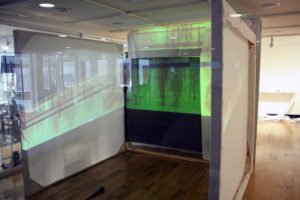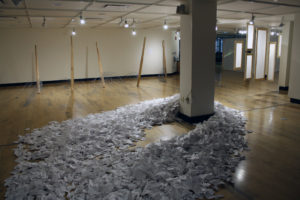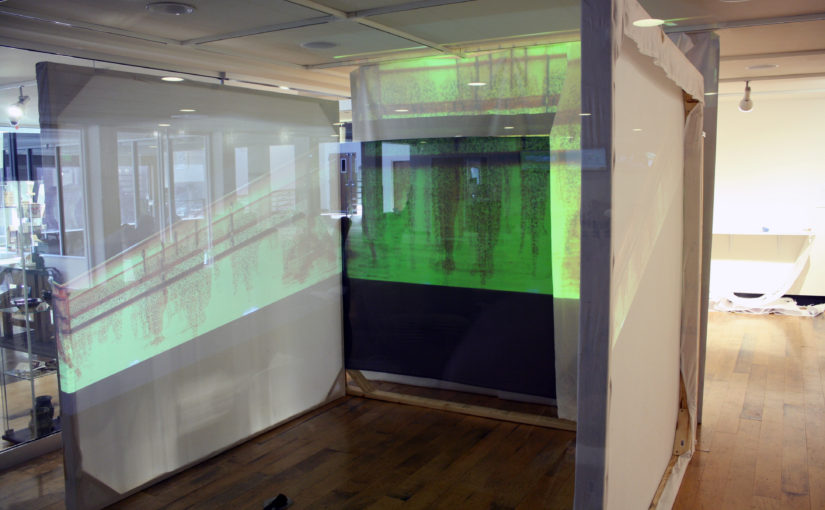
Using layers of screens and projections, Bailey Nelson questions what makes the architecture of American high schools in her 2017 piece, “Gestalt.”
The work on display looks more like contemporary art than the research of architecture students. Each work is stranger than the next, featuring broken cups, metal and wire sculptures and crumpled pieces of paper.
But each student’s design is a glimpse into the conceptualization of architecture before the final design.
“Speculative Architecture and Oblique Representation” was on display in the Memorial Union Gallery from March 7 though March 23. The students on display were graduate students in the College of Architecture, part of professor Stephen Wischer’s thesis studio.
In his studio, Wischer challenges his students to “create artifacts” of the sites they’re researching and designing before drawing up plans. This allows the students to gain a unique perspective on the space and it gives them the chance to break traditional architectural boundaries.
Student Diedrich A. Harms, in his piece “The Recovery of St. James,” used broken cup and strips of paper to represent addiction in his research of an addiction center.
Each cup has been pulverized, leaving scars along the pristine white paper. This also leaves the mugs unusable, taking away their original purpose.
“You’ll notice when you’re looking at the work, the vessels are together but they’re in a completely different form so they may not be able to be utilized in the same way,” Memorial Union Gallery coordinator and curator Anthony Faris said. “They can’t hold things the same way, but in a way, they’re holding themselves. For an exploration of addiction and the process that you do when you lose yourself and try to put yourself back together, this is a pretty wonderful metaphor.”
Beside Harms’s piece is Richard J. Maas III’s creation, “The Creator: A Disposition on Play, Symbol, and Festival.” The plain, yet stark, wooden frames with delicate pieces of tissue paper, is meant to be an “institutional critique of museums.”
Along the right wall are the precarious statues of Natalia Jara. Using wood and metal wire, Jara designed perfectly calibrated statues that look as if they could topple at any moment, but that miraculously hold their stature.
“There’s this idea that we’ve sort of separated ourselves from nature and so we feel really safe,” Faris said. “All these pieces sort of hang by themselves — they hold themselves up. But they are precarious. There’s a possibility of them falling by somebody knocking them over.”
Jara’s piece is interactive, like many of the pieces in the exhibition. With assistance, viewers can take one of the statues and try to lower it to the ground. While it seems easy at first, the lower the statue goes, the harder it is to maintain your grip on the piece. It inevitably falls to the ground with the clatter of metal hitting wood.
“As you get closer to the ground, there’s something that happens,” Faris explained. “You feel a sort of sense of stability and you feel like you’re gonna be able to do this. You feel almost a sense of safety. But then by the time that you get down to the bottom, there’s a humbling that happens. And that’s what happens in natural disasters. All the things that you’ve taken for granted are erased.”

Kara Iliff examines the effect of industrialization on clean water in her piece, “Echo: Nature-inspired Architecture as a Method of Cleansing Freshwater in the Wake of Industrialization.”
Moving further into the exhibition, viewers see Kara Iliff’s piece on clean water, entitled “Echo: Nature-inspired Architecture as a Method of Cleansing Freshwater in the Wake of Industrialization.” Iliff soaked 4,000 different pieces of paper to display what effect water has.
Gretta Berens, in her piece “Viscer(l): A Linkage Between Internal and External,” explores irritable bowel syndrome.
A prone figure lies helplessly at the end of a tunnel of string. In order to get close to the figure, viewers must “get in the shape of the body. Your body has to move in the same way that the body does.”
Aaron Warner uses projections and a camera to explore time and space in “Horizons: Integrating Digital Technologies to Propel and Inspire Cosmic Progress.”
“One thing that he was thinking about was time and space and how much time it takes for light to come,” Faris said.
Viewers can move in front of the projection and see themselves through time. Candles encircle the piece, making an interesting connection to light and weight.
Warner encourages viewers to write a burden or weakness on a note, and then place it under a candle. This action allows the candle to hold the weight, visually taking the burden off the viewer.
Like Warner, Bailey Nelson incorporated projections in her study of how students influence the architecture of high schools. Projections within a box show a girl moving, bringing extra activity to the already active exhibit.
“The work in this exhibition is much more geared toward interacting in space than in other exhibitions we’ve had in here,” Faris said. “I think this is the first exhibition that is pretty much all 3-D work.”
In total, 11 students are in Wischer’s class, but the MU Gallery could only host seven of the 11. Faris was very grateful for the students featured, who were very willing to talk about their pieces, attend the reception and engage with curious viewers.
While the pieces are beautiful to look at, their primary purpose is for research.
“Their work was on display in the architecture department, but the work is created as an artifact for their research so it’s usually created, critiqued and then is taken down,” Faris said. “This has turned that situation into more of a celebratory experience of allowing it to exist for longer and to be able to participate with it, which hasn’t been done before.”
Faris said the gallery is planning on hosting the exhibit again next year, hopefully allowing another round of creative research to be on display.
